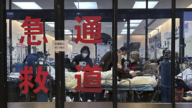【新唐人2011年11月25日讯】中国的制造业正在萎缩,根据香港汇丰银行“采购经理指数”(purchasing managers’index)数字显示,中国制造业11月降到32个月来最低点,出口订单一项也出现下滑,中国制造业明显步入萎缩。专家分析指出,制造业是中国的支柱产业,一旦萎缩,对整体经济是致命性的打击。
“采购经理指数”是国际通行的衡量宏观经济的指标。
汇丰银行11月23号公布11月中国制造业采购经理人指数预览,数据从上个月的51降到了48,这是自从2009年3月以来最低的一个数字。显示中国制造业步入萎缩的区间。
“制造业采购经理指数”主要是通过订单、生产、就业、库存,以及物流等分项指标,来反映制造业活动。指数高于50%表明制造业总体扩张,反之则意味着收缩。
美国纽约城市大学经济学教授陈志飞接受《新唐人》专访谈到,中国制造业去年还在蓬勃向上,出口增加,今年出口已经连续三个月呈现下降趋势,制造业恶化的速度非常快。陈志飞认为,中国的经济在硬着陆。
美国纽约城市大学经济学教授陈志飞:“制造业的萎缩,对于一个国家来说是致命的,因为它是一个支柱产业。那么讲到中国这么一个依靠制造业为主的所谓世界工厂,它竟然跌到了48%,这的确是拉响了警报,而且最让经济学家担心的是,这个预示着中国经济会硬着陆,如果是硬着陆,不是缓慢的下降,你是突然下降坠地,那就是整个机毁人亡,会造成很大的灾难。”
陈志飞教授分析了造成中国制造业萎缩的几点原因。
美国纽约城市大学经济学教授陈志飞:“欧债危机造成整个欧洲对外的需求减少。欧美的减少是造成中国制造业客观上生存的危机。内部的话,主要是中国整个的基础建设项目、中国的银行借贷现在都收紧,造成需求减弱;楼市现在已经开始崩溃,所以使得需求各方面减少。”
陈志飞教授还指出,中国高通货膨胀的环境还在进行,另外,随着人民币有可能对美元走跌, 中共当局可能采取放宽货币政策,将进一步削弱国内的需求,造成制造业的萎缩。他估计,中国经济现在正处于滞胀的前沿。
美国纽约城市大学经济学教授陈志飞:“今年虽然世界银行还在估计中国的发展速度,从去年的10%降到今年的9.5%左右,但是在两三年内可能会降到6%甚至以下。通货膨胀如果恢复到6%甚至7%的水平的时候,我觉得是一个完全的一个滞胀的形势,那么将是中国经济崩溃的一个明显的信号。”
伦敦宏观经济研究机构“凯投宏观”在23号发出的分析信函中也表示,价格方面的数据显示,通胀已经成为一个迅速削减中国经济发展的威胁,而比预期更糟的“中国制造业采购经理指数”数字表明,中共当局不久前暗示的“微调整”可能已经不足以避免经济下滑。
新唐人记者周玉林、周平、薛莉采访报导。
Experts say shrinkage China’s Manufacturing Shrinkage Foretells the Coming of Stagflation
China’s manufacturing is shrinking now.
According to the latest Purchasing Managers’ Index (PMI)
announced by HSBC, China’s manufacturing activities fell to its lowest point in 32 months.
Specifically, export orders appeared to be decreasing as well,
which is an apparent signal for the shrinkage.
Experts pointed out that the manufacturing sector is the pillar
industry of China, thus its shrinkage is a critical alarm to the whole country’s economy.
The Purchasing Managers’ Index (PMI) is a globally-used
indicator of macroeconomics.
On Nov 23, HSBC announced a preview of
China’s November PMI.
The index appeared to fall from last month’s 51 to 48,
which is its lowest point since March in 2009.
What’s more, 48 is already in the interval indicating shrinking
manufacturing.
PMI is a composite indicator reflecting manufacturing activity,
which is calculated by several indicators for new orders, production, employment, stocks and logistics.
A number over 50 indicates a growing manufacturing activity,
otherwise a declining one.
Economics professor at The City College of New York,
Chen Zhifei, told NTDTV that
China’s manufacturing was still growing last year with
increasing exports;
however, in the recent three months, export orders continuously
dropped and the manufacturing quickly turned to a shrinking trend,
which made him believe that China is undertaking an
economic hard landing.
(Economics professor at The City College of New York,
Chen Zhifei) ”The shrinkage of manufacturing is critical because it’s usually a pillar industry of the country.
Especially for China, who is known as a “global factory” which
largely relies on manufacturing, a PMI of 48 is really a critical alarm to its economy.
What worries economists most is that such a dramatic change
in PMI suggests an economic hard landing of China’s economy.
If it’s a hard landing, not a soft one, then the craft of China’s
economy will suffer a fatal crash which would be a terrible catastrophe.”
Prof. Chen made an analysis on possible reasons inducing
the shrinkage of China’s manufacturing.
(Economics professor at The City College of New York,
Chen Zhifei): “Internationally, the European debt crisis has reduced those countries’ demands from oversea markets.
Such reduction is an objective threat to China’s manufacturing
companies.
Domestically, infrastructure projects and bank loans are both
contracting in whole; the real estate market also starts to collapse.
Everything mentioned here has reduced the total demands on
the manufacturing industry.”
Prof. Chen also mentioned that China’s inflation
is still very high; on the other hand, as Yuan might decrease against dollar,
the CCP might loosen its currency policy which would
further weaken domestic demands and shrink manufacturing activity.
He speculated that China’s economy is currently at the edge of
stagflation.
(Economics professor at The City College of New York,
Chen Zhifei): “Though The World Bank still estimates a 9.5% annual growth rate of China’s economy this year,
this number could drop to below 6% in two or three years.
If the inflation rate recovers to 6% or 7% at that time,
in my opinion, such situation turns out to be a complete
stagflation, which would be a clear signal for the collapse of China’s economy.”
The London-based macro-economic research consultancy,
Capital Economics, wrote in an analyzing letter on Nov 23rd that,
the price data shows that inflation has become a huge threat
in impairing China’s economic growth; the worse than expected PMI also indicates that,
the “fine adjustment” recently suggested by the CCP
might not be enough to prevent China’s economy from falling into shrinkage.
NTDTV reporters Zhou Yulin, Zhou Ping and Xue Li





























